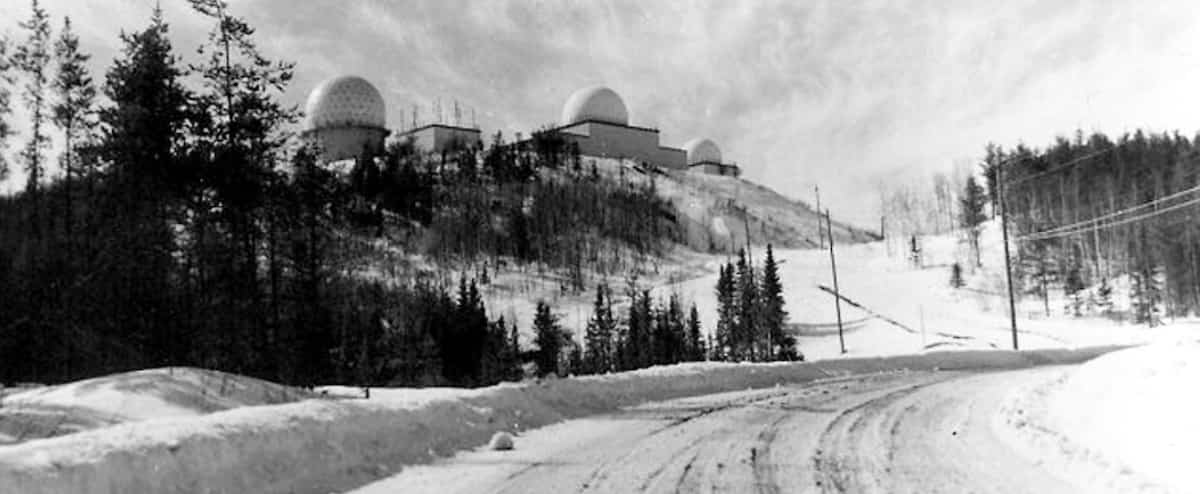Just 135 km east of the town of Clova, currently threatened by forest fires, is an impressive relic of the Cold War: a huge airstrip dating from 1953, capable of accommodating B- 52 Americans. It extends in full forest zone of Haute-Mauricie.
• Read also: Clova saw German soldiers parade: the village of Haute-Mauricie resists time and flames
“This track was part of a Canadian-American defense system called the Pinetree Line, which included 52 radar stations across Canada,” says military historian Michel LItalien.
Illustration provided by Mathieu-Robert Sauvé
The Pinetree Line as depicted in 1960
The development of this defense system dates from the post-war era, at a time when tensions between the Americans and the Russians of the Union of Soviet Socialist Republics (USSR) were at their highest. What has been called the Cold War pitted the Western bloc, made up of the United States and its allies, against the Eastern bloc, made up of the USSR and its satellite states.
Fearing an attack from the North, the United States obtained the collaboration of Canada for an ultra-secret project: to install a system of detection of enemy military activities coming not from the oceans, but from the Far North.
33 bases
The Pinetree line was a network of 33 radar stations installed along the 49e parallel between Holberg, British Columbia, and Saint John, Newfoundland. Seven of these radar stations were built in Quebec.
“The buildings on Mount Radar are still in good condition, even if the roof of the main bunker is leaking,” explains Chantal Deschênes, who works at the Domaine du Radar outdoor base, a campsite in Saint-Sylvestre, south of Levi’s.
Each year, guided tours are organized to allow the public to discover this former military base. Baptized by the name of the village where it is located, it counted at one time up to 2500 people, who lived there permanently.
The buildings of these military bases, which surround the installations, were “real mini communities” which had to be completely self-sufficient, can we read on the site of the Regrouping of information on the forgotten vestiges of Quebec.
These mini villages had schools, community halls and even a swimming pool, a bowling alley. Not to mention the garages, the running water and electricity system for the dwellings.
Dismantled in 1964
In fact, the defense systems of the Pinetree line have never been used. More modern and more effective, the radars of the “Mid-Canada Line” and the “DEW Line”, established up to the polar circle, will gradually replace them.
The Pinetree Line facilities were dismantled in the 1960s. But many buildings are still in place.
The maintenance of these vestiges of a bygone era also poses problems, because many are located on private land.
Explorers from Haute-Mauricie have, for example, discovered, near the Casey airstrip, disused wells around the old control tower.
Pinetree line radar stations in Quebec
Photo provided by RIVOQ
The Casey radar base, in Haute-Mauricie, in the 1950s. It was part of the Pinetree line, set up to monitor Soviet military activities.
Senneterre: Located 70 km north of Val-d’Or. Commissioned in 1953. It was the alternate command center for a possible nuclear attack. Decommissioned in 1988.
Chibougamau: Commissioned in 1962. Modified a year later to contribute to new aerial imaging technologies. Decommissioned in 1988.
St-Denis: Commissioned in 1952. The station has changed names and vocations several times. It has been a radar base, a training base for fighter aircraft controllers and a training school. Decommissioned in 1985.
Parent (Casey): It entered service in 1953. It was modified 10 years later to contribute aerial imaging technologies, but was quickly deemed useless, as other more modern stations already covered its area. Decommissioned in 1964.
Apica: Commissioned in 1952. At one time it had about 500 serving officers. It was forced to close in 1990. The station’s weather radar is still maintained by Environment Canada. His military village was demolished.
Saint Sylvester : Commissioned in 1953. This station is further south than the others on the Pinetree line to cover part of the eastern seaboard of the United States. Decommissioned in 1964.
moldy: Commissioned in 1953. It was mainly used for search and rescue. Decommissioned in 1988.
Source: Grouping of information on the Forgotten Vestiges of Quebec rivoq.ca/pinetreeline
Casey, the smugglers’ secret trail
Photo provided by pilots.quebec
The Casey track, in Haute-Mauricie, dates from 1953. It was officially abandoned in 1964, but remains usable.
Still used today by private pilots, Casey’s airstrip had its heyday when cocaine smuggler Raymond Boulanger attempted to deliver the largest drug shipment in Canadian history there.
The Convair plane is carrying 4,000 kg of cocaine from Colombia in its hold. Six people will be arrested in this case, including three chilled fugitives found in the woods. Raymond Boulanger receives a 23-year prison sentence.
The pilot will be talked about because of a wink he throws at the photographer of The PressRobert Nadon, on his arrest for the two escapes he carried out during his sentence.



